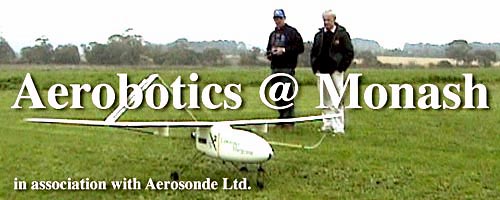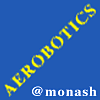

Aerobotics© at Monash UniversitySignificance, Impact and Contribution to Australia's Economic Development
by Robert Mahony and Bijan Shirinzadeh
The proposed research direction in Aerobotics is directly motivated by the existing potential of autonomous mobile robotic applications. Recent advances in computer and sensing technology, and the associated reduction in cost of such systems, have made the physical construction of autonomous mobile robotic systems possible at a reasonable price. It is possible to buy fully functional, radio controlled model aeroplanes, helicopters or dirigibles made for enthusiasts. Such models come equipped with most of the desired actuators fitted in order for the remote pilot to control the vehicle. Obtaining sensors and suitable electronics and integrating the whole into an on-board architecture for autonomous operation is a relatively straightforward, if not simple, task for a good engineering staff. Possible applications include remote sensing, search and rescue missions, bush fires surveillance, regular checks on the state of power lines, gas lines, fences etc. over long distances, military applications, surveillance in dangerous situations (monitoring volcanoes etc.), coast watch applications and surveying the structural integrity of bridges and buildings. An important consideration for the commercialization of unmanned aerial vehicles (UAVs) is that the vehicle is typically considered to be expendable. This contrasts strongly to existing aeronautical applications where the potential loss of life associated with aircraft failure drives one to implement the most reliable systems possible. It is of significant commercial interest to consider inexpensive fabrication procedures and components for the construction of UAVs and solve the problem of reliability by using multiple platforms. This approach introduces a different set of priorities in autopilot design than that encountered in traditional aviation applications. No longer is the safety of the aircraft of paramount importance and the reliability of the components guaranteed, rather the focus shifts to obtaining better performance using inexpensive components and partial information. There is always an issue of safety if a UAV crashes into inhabited areas, however, the applications considered have no risk of such an occurrence and these issues do not effect the underlying control design. In accordance with a philosophy of developing a robust autopilot system for the new wave of commercially viable inexpensive and highly responsive UAVs the following key issues have been identified:
A potential exists to develop and market sub-systems tailored to solve the fundamental problems in applied UAV systems Australia wide and worldwide. Students from the initiative will become available to companies working in these areas and contribute to the international profile of Australia in UAV applications. The unique geography of Australia leads to many more potential UAV applications than may be found other countries and provides a fertile environment for companies to grow and develop technology once the fundamental problems are resolved. The growth of the UAV industry worldwide is tremendous, however, most existing applications are military in nature and technology developed to date is prohibitively expensive. The new paradigm of inexpensive, robust UAV systems is an exciting development that promises great economic potential. The proposed research group is certainly not the only Australian contribution to the field of UAV systems, however, it is a strong industry academic link in this area and an opportunity to solve real world problems while contributing strongly to Australia's future economic position.
Robert Mahony
The term Aerobotics is © Copyright 2007, CTIE
|